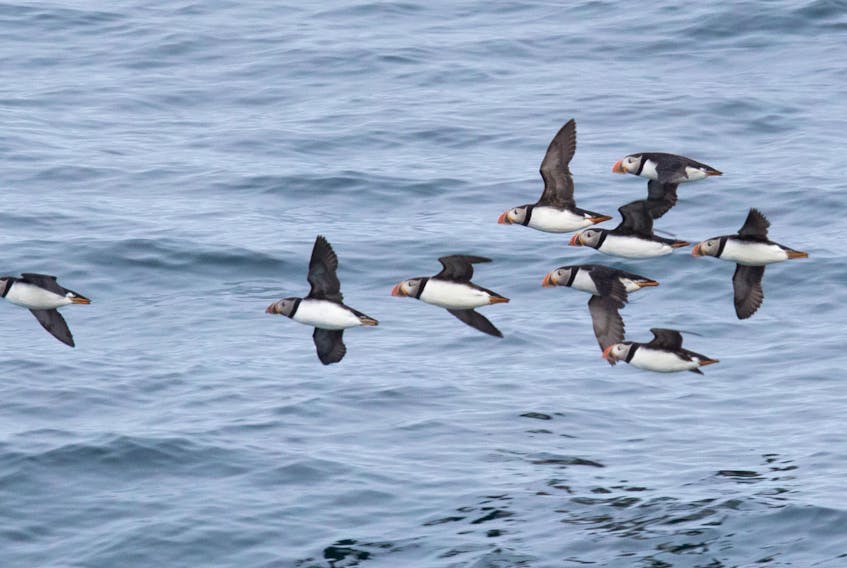The middle of summer is a pleasant time to be outdoors. The impressive greenness of the forest, bogs and barrens is something to behold. Roadsides are full of colourful flowers. Dragonflies, bees and butterflies are thriving in the lush vegetation.
Mid-summer marks the winding down of the caplin season. However, after spawning there can still be large caplin concentrations present near the coast. I am not a caplin biologist but I believe these late caplin concentrations are fish that lived through the spawning effort but may be near the end of their natural life. These late caplin concentrations extend the caplin feeding season for birds and whales by a couple of weeks. Nesting seabirds are still feeding young and seek out these late caplin concentrations to catch food to bring home to feed the growing young.
If you stand at tip of Cape Spear now you will see flock after flock of puffins and murres streaming by at high speed. They are either on the way to a known caplin hot spot or heading back to their nesting island with the shiny fish carried in their beaks. Young puffins sit in their burrows on a nesting island waiting for the caplin dinner. They have to stay deep in the burrow to keep out the reach of the predatory great black-backed and herring gulls patrolling the colony. Meanwhile, the adults bringing home the dinner have to be swift like a mouse when they land on the island to avoid losing their fish to the crafty gulls.
The group of juvenile savannah sparrows feeding in the grass along the Cape Spear walkway were on their own without adult guidance. The adults were probably hiding in the grass trying to avoid the youngsters!
The murres do things differently — taking their chick out to sea and away from the busy colony a few days after they hatch. The parent murre feeds the chick as they swim far out to sea.
Seabirds work hard to get the caplin to bring home. Any time you see diving gannets, think about how far they have come to fish for food. There are only three nesting locations for the gannets in Newfoundland — Cape St. Mary’s, Baccalieu Island and Funk Island. Every gannet you see comes from one of these three islands.
Seabirds are great travellers. They have the speed and endurance for long-distance commutes between the caplin and their nesting island. Sometimes the caplin come to the birds. Last week there was a huge swarm of shearwaters and whales feeding on a large caplin concentration at Cape Bonavista. This was convenient for the few thousand pairs of puffins that nest around the Bonavista Peninsula.
Long-distance travellers
Birds like the shearwaters can follow the food source wherever it takes them. The great and sooty shearwaters nested during our winter way down deep in the Southern Hemisphere so have no young to feed now. They can eat all that they catch but they sure came a long way to get here to take advantage our caplin abundance. Terns and gulls go for the caplin when it is convenient in their nesting areas. Even loons fly out to the coast to gorge on caplin during times of abundance.
The caplin spawning season is a very important part of the year for local nesting seabirds as well as seabirds from distant lands. A healthy caplin population equals a healthy marine bird population.
As the seabirding action winds down, birders turn their attention to the increasing passage of southbound shorebirds. Arctic nesting shorebirds have begun their southbound migration. This past weekend things picked up with small groups of ruddy turnstones being reported from a number of locations. The few individual white-rumped sandpipers around now will turn into numerous flocks over the next two weeks.
The trickle of semipalmated plovers passing through this week will become a river of migrants as August arrives. Among the mixed shorebird species flocks, sharp-eyed birders will pick out sanderlings, least sandpipers, pectoral sandpipers, lesser yellowlegs, short-billed dowitchers and more.
Most woodland birds are coming to the end of their nesting season. The worn-out adults are in the process of starting their summer break. After a frantic few weeks of rearing a family, the parent birds need the break. The group of juvenile savannah sparrows feeding in the grass along the Cape Spear walkway were on their own without adult guidance. The adults were probably hiding in the grass trying to avoid the youngsters! A growing flock of swallows feeding over Mundy Pond in St. John’s is comprised of nearly all juvenile swallows learning the ropes on how to be a swallow. The two juvenile flickers I flushed off a woodland path seemed to be on their own. All through the woods young warblers, sparrows, kinglets, flycatchers and more are learning to fend for themselves.
Feeding themselves is the most important first step in making it on their own in the world of birds. In this time of abundance, it is easy to get going.
Bruce Mactavish is an environmental consultant and avid birdwatcher. He can be reached at [email protected].









